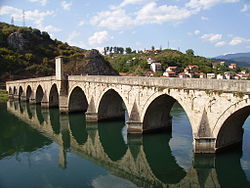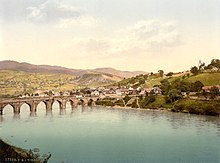Drina Bridge (Višegrad)
| Mehmed Paša Sokolović Bridge in Višegrad | |
|---|---|
|
UNESCO world heritage |
|

|
|
| The Mehmed Paša Sokolović Bridge in Višegrad |
|
| National territory: |
|
| Type: | Culture |
| Criteria : | (ii) (iv) |
| Surface: | 1.5 ha |
| Buffer zone: | 12.2 ha |
| Reference No .: | 1260 |
| UNESCO region : | Europe and North America |
| History of enrollment | |
| Enrollment: | 2007 (session 31) |
The Bridge on the Drina or Mehmed Paša Sokolović Bridge ( Serbo-Croatian Most Mehmed-pase Sokolovica / Мост Мехмед-паше Соколовића , Turkish Sokullu Mehmet Paşa Köprüsü ) in the town of Visegrad in Bosnia and Herzegovina was built by 1571 to 1577/78 . It has been on the UNESCO World Heritage List since 2007 .
The builder is considered to be the Janissaries - Grand Vizier Sokollu Mehmed Pascha , who came from a village near Višegrad and who came into the boy harvest at the age of ten . He is said to have commissioned the construction to do his homeland a service. On the central stele of the bridge there are two text panels on which , according to Ivo Andrić's novel, the following inscription can be read in Ottoman Turkish:
- See Mehmed Pasha, the greatest among
- the wise and great of his time,
- fulfilled the promise of his heart,
- and with his care and zeal
- he built a bridge over the Drina river.
- Over this water, deep and fast,
- his predecessors couldn't build anything.
- I hope from the grace of God
- that this building may be solid for him,
- that his life would be in happiness
- and he never experiences grief.
- Because throughout his life he has gold and
- Silver donated to foundations;
- and nobody can say
- that a fortune is wasted
- that was used for such purposes.
- Badi, who saw this, spoke,
- when the construction is completed, the following dedication:
- God bless this building
- this wonderful and magnificent bridge!
The planning of the bridge is attributed to the Ottoman builder Sinan . The bridge consists of eleven arches and is about 180 meters long. The lane, which is now closed to car traffic, is six meters wide. The large platform on the central pillar ( Kapija ) served the residents of the city of Višegrad as a meeting point for centuries and the changing rulers in the city as a checkpoint on the road from Sarajevo to Serbia . In 1914 three arches of the bridge over the green Drina river were destroyed by the retreating Austro-Hungarian occupation. An explosive device had been installed beforehand. In 1940 the bridge was reconstructed. The damage caused by the Second World War was repaired in 1951. Today the water level, which has risen due to the damming of the river near Peručac, threatens the building fabric.
Ivo Andrić , who received the Nobel Prize for Literature in 1961 for his complete works , describes the history of the bridge and the city in his novel The Bridge over the Drina , published in 1945 . The bridge is also the subject of the novel How the soldier repairs the gramophone by Saša Stanišić .
Individual evidence
- ↑ Aptullah Kuran: Sinan: The Grand Old Master of Ottoman Architecture. Washington DC and Istanbul 1987.
- ↑ UNESCO World Heritage List
literature
- Ivo Andrić: The bridge over the Drina - A Wischegrader chronicle .
Web links
- Entry on the UNESCO World Heritage Center website ( English and French ).
- Entry in the list of endangered sights
- Stone bridge over the Drina near Višegrad - illustration in the Allgemeine Bauzeitung , 1873
Coordinates: 43 ° 46 ′ 56.3 " N , 19 ° 17 ′ 17.1" E

